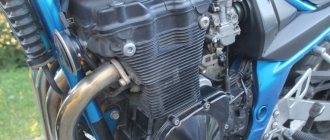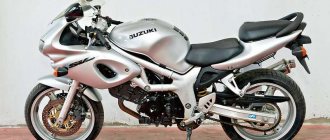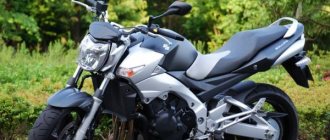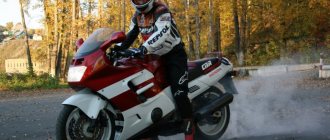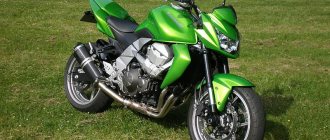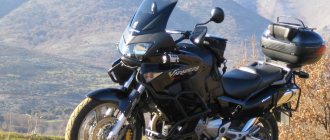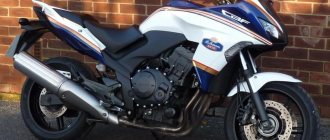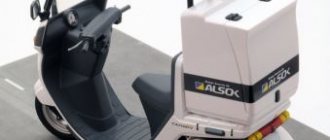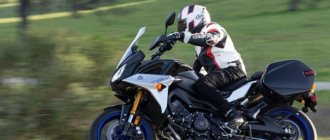One of the interesting discoveries of the motorcycle exhibition 1991 In Tokyo, the Honda CB 1000 road worker model has become available. According to the developers themselves, the model continues the traditions of the CB400, but is designed for those for whom these cubes are not enough. According to the tradition established by the 400th model, it is called Super Four, although it is abandoned at the start of production. This label is only on bikes 1992 production.
Story
Honda CB 1000 is a typical classic, about which they say that it is “iron” and “real”.
Every year the bike opens up new sales markets:
- 1992 - start of production and delivery to Japan and Asian countries.
- 1993 - Japan + Europe.
- 1994 - The USA is added to the list.
- 1995 - Deliveries to the Australian mainland begin.
But this is where the star of the bike sets. For each market, the developers used their own frame and capabilities and decided that pulling all this was not profitable. In 1997, the “blackbird” appeared on the market; the four gave it its place on the assembly line. In 1998, an updated Sibiha appeared with a larger engine capacity - Honda CB 1300.
It should be noted that the developers tried to return the CB 1000 to the market. In 2007, the CB1000R was introduced to the public, but it became a completely different bike. Everything has changed, from the frame to the suspension. Despite the ongoing production, this model was never able to achieve the glory of its predecessor.
Reviews
Reviews of Honda CB1000R:
Expand Collapse
Great bike for the city! Beautiful unusual Italian design, monopendulum! Good! we can say excellent acceleration dynamics, I would like the brakes to be better; for a weight over 210, it seems to me that it stops slowly. The donor for it was the CBR 1000RR until 2007, before that I rode sports, in city mode it is extremely inconvenient!
The CB 1000R has excellent handling, a comfortable seating position, long gears, a shorter drive and a rest, a derated engine (123 hp) will not give any offense to sports. The most comfortable maximum speed is 220 km/h, maybe 240, but just hang in there)))))
Now for the consumables! I have driven 7000 km for a season and a half, changed the oil twice, brake fluid, rear air cylinder, front pads. It’s better to take EVERYTHING original, it’s a little expensive, but it’ll give you peace of mind! I only use 98 Benz. HONDA 10w30 oil.
I have a CB1000 RA. I skated the season almost every day, mostly in good weather, although I was in the rain a few times. What can I say? Before that I had a Yamaha Thunderrace 1000. I was disappointed in all aspects, so I chose only a Honda, mainly for the city and traffic jams, with short trips somewhere and specifically with ABC. I’ll say right away that the motorcycle did not disappoint. Confident traction from the very bottom with pick-up at 6500. It quickly picks up speed with the lifting of the front end, but everything is very controlled. Turning the speedometer over 200 km/h is no problem. But somewhere around 230 you need to lie down on the tank. Extremely friendly to the pilot, forgives many mistakes. One combined braking system with ABC is worth it: in any weather, on any surface, with any force on any brake. It's a pleasure to pierce plugs on it, despite its 225 kg curb weight. It steers very easily and takes turns in such a way that the comrades driving behind are surprised. Although I noticed this nuance: with a passenger weighing up to 50 kg, turning turns is much easier and more interesting. In short, I have never regretted the purchase. Among the additional features, I installed an alarm system, a GIVI windshield, xenon, a case with a GIVI mount, and, of course, sliders. For more than seven thousand I did two maintenance (break-in and mileage); The rear balloon can be thrown out in the spring (the VT-015 is a bit weak for it). The rest is just a thrill.
I became the proud owner of a cb1000ra 2012. Before that I drove a fz6s 2006. I’ll make a reservation that I haven’t driven a phaser-liter, but I’ve read about it. I'm still shocked by my Honda. And this takes into account the uncompleted run-in and the nauseating mode. The way it steers is incredibly delightful. For the city, I think, the most ideal bike. The box is singing! Everything is clear and harmonious. even at the bottom, without crossing the 5 thousand rpm mark, it has excellent dynamics! Very smooth motor. No pokes when closing the throttle. In short, I would marry her. If you go long-distance, then a phaser is of course better, but otherwise... I'm now a devoted fan of the cb1000r!
Ps: the lack of wind protection is ultimately a plus, because Necker can drive 200 in the city :acute: . I sinned myself, but now I’m glad that it won’t be comfortable to shoot like that)
Specifications
As was later the case with the Thrush, the bike was equipped with a derated engine from the CBR1000F.
Engine – left view.
Engine – right side view.
As a result of the adjustments, the maximum power dropped, but the thrust at low and medium speeds increased. Like its “younger sister,” the motorcycle had 4 cylinders, arranged in a row, operating on a 4-stroke circuit.
- Working volume - 998 cm3;
- Power - 99 hp (for Japan 93) hp;
- Number of valves - 16;
- Cylinders - 4;
- Cooling - liquid;
- Fuel supply - Keihin 34 mm carburetor;
- Ignition - transistor;
- Start - electric starter;
- Fuel tank - 22 l.
The versions supplied to the Japanese market were additionally “stifled”, which reduced power, speed, torque, but did not affect traction.
Transmission and clutch
The motorcycle received a 6-speed gearbox.
The main drive is a classic chain drive.
According to user reviews, the box is good, but you need to get used to it . Turning on gears with a knock is normal. The range of possibilities is ideal, you can spin it up to red in first, and switching to higher gears will not be a problem. The bike accelerates confidently and well according to the pilot’s commands, no jerks or surprises .
Particularly noteworthy is the grip. You can safely drive in 5th gear at a speed of 20 km/h, there is no feeling that the engine will stall or you will fall. It is multi-disc, in an oil bath.
- Transmission of force by means of a cable.
- Main drive - chain.
Brakes
Front brakes.
Rear brakes.
The concern's usual Nissin disc brake system was configured in such a way that, according to users, the motorcycle bites into the asphalt, and when the front wheel locks, you're afraid you'll fly over the handlebars.
Front:
- number of disks - 2;
- disc diameter - 310 mm;
- support - 4 piston.
Rear:
- number of disks - 1;
- disc diameter - 276 mm;
- support - 1 piston.
No options were developed. In recent editions, the pistons and brackets of models supplied to the Japanese markets began to be painted gold, such as Brembo .
Chassis and brakes
The CB 1000 has a duplex frame made of steel. The abundance of metal in the exterior immediately catches the eye. Although this is a classic motorcycle, the wheels are alloy. The steering wheel is very comfortable and has traditional dimensions for this class.
As for the suspension, at the rear there is a pendulum version with a double shock absorber, at the front there is a 43 mm telescopic fork. This is a completely natural solution for the class.
The rear brake is a 276 mm disc with a single-piston caliper, and the front is a pair of 310 mm discs with four-piston calipers. It is these components of the bike’s chassis that react particularly sharply to sudden changes in speed and other sporting habits of the rider.
Dimensions and weight
The large dimensions of the motorcycle require appropriate handling and it may simply be uncomfortable for a short biker to ride it.
Considering that the only change in the parameters of the motorcycle is the sincerity of individual models, the same external parameters throughout the entire production are not surprising. The mass was:
- dry - 235 kg ;
- equipped - 260 kg (Boldor - 263 kg ).
With the exception of modifications in 1994, the dimensions did not change. The bike had:
- length - 2221 mm ;
- width - 781 mm ;
- in height - 1130(11161) mm ;
- seat height - 810 mm ;
- wheelbase - 1541 (1535) mm ;
Dimensions in brackets are for the Boldor version.
Modifications
By analogy with the four, the motorcycle has two modifications: Naked and Boldor .
The name of the second is no coincidence. Just like the 400, it has a stock windshield, a front body kit and a square headlight. In some assemblies, the headlight remained round, the body kit had a cutout for it.
Model Honda CB 1000 Boldor with a square headlight in a rather voluminous fairing.
Competitors
The new model was in many ways the same as the 400, but at the same time it was a completely separate bike. In terms of quality characteristics, it can be noted that only models of larger cubic capacity could compete with it.
- Yamaxa called the XJR 1200 . The big difference was air cooling. Otherwise the difference is insignificant.
- Suzuki offered two bikes. Bandit 1200 and Inazuma 1200 . The models were equivalent to each other, but differed from the Honda in air cooling. Bandit offered ABS as an option.
- Kawasaki exhibited three models. Zephyr 1100 - air cooling, 2 valves per cylinder and a pair, one of which was a logical continuation of the other. ZRX 1100/ZRX 1200 . The differences between them were only in engine size and years of manufacture. The main filling duplicated the Honda.
Difficulties in choosing - Honda CB 1000 or Kawasaki Z 1000?
The liter Kawasaki of the 2000s is essentially a completely different motorcycle, although it still bears the old markings.
Users place other models next to the Honda. The most common is Kawasaki Z1000.
- One of Kawasaki's advantages is the continued production of the model. CB 1000 closed 20 years ago.
- The second is the presence of an inverted fork and a full range of settings .
- The third is the injector .
But despite all this, only Honda models, and the one described here, are no exception, insure the user against errors. And even if he does, they won’t lose control. Well, what is more important - safety or new features - everyone usually decides for themselves.
Cafe, racing and a little neo: Honda CB1000R Neo Sports Cafe
Each of us has probably come across ratings of the most common surnames; in Russia there are approximately 400 of them. Unlike human surnames, no one considers the prevalence of motorcycle surnames, and in vain - the “Honda” CB family would probably have taken a place in the top three if it had not topped the entire rating. Only in my garage over the last decade there have been three Honda CB 400s, two CBR 1100s and a CBR 900, and even today there is a “Sibiha” in the family, albeit with a proper name – Hornet 600.
Over the past three decades, almost every type of seabird has been brought to Russia, from the CB50 moped to the huge CB1300. That is why the new “Sibiha” of the 2021 model year simply could not go unnoticed by us, meet the Honda CB1000R Neo Sport Cafe. Complicated name, isn't it? The motorcycle received such a fresh design that the Japanese decided to distance themselves as much as possible from other tribesmen, and especially from the Hornet.
Video version of the test drive of the Honda CB1000R Neo Sports Cafe motorcycle:
But the new product is flesh and blood Hornet! Judge for yourself: the derated engine from the CBR1000 and the steel backbone frame made of a rectangular profile are two ingredients that defined the models of past years. By the way, the previous generation CB1000R departed from the classic Hornet - its frame was made of aluminum, and the cantilever swingarm was somewhat out of line with the ideology of a sportbike for every day.
The design is both recognizable and modern, and most importantly, does not stand out from the corporate design DNA of the SV family
However, the steel frame did not spoil the new product: the rigidity was in perfect order, and the weight was not only kept at the same level, but also reduced by eight kilos - 212 versus 220 in running order. Quite a lot, but the competent distribution along the axes and the low center of gravity do their job, the motorcycle feels very light. This is partly due to the heavy cantilever swingarm and license plate bracket on it; partly due to the design of the frame, which now ends at the pendulum mount; the saddle is already screwed to the aluminum subframe.
The lack of wind protection is rather a plus for the city heat, but for high-speed shooting you have to wear a suit
The chassis has generally taken a big step forward both in terms of emotions and quality: the suspension is adjustable, the “reversal” with thick pipes has separate adjustments. On the right feather there is a spring preload, the screw of which can be rotated with an ordinary ruble coin, on the left there is hydraulics, here you can’t do without a screwdriver, softer, harder, everything is at your service.
The same goes for the rear monoshock. However, if the front suspension works perfectly, then there are questions about the rear - the standard adjustment is too soft, the stern literally “floats”, however, adding rigidity due to adjustment will only partially save - the unsprung masses are too high.
The “reversal” adjustments are spread across the feathers, which is not only more technologically advanced, but also more convenient for the user
They are determined both by the “console” with a number and by the wide rear wheel, now shod with 190 tires. You have to pay for the image, you know. And it’s not sour to pay - the basic configuration of the Honda CB1000R Neo Sport Cafe costs from 1,099,000 rubles, but in nature there is also a “packaged” Honda CB1000R Neo Sport Cafe +, which, according to our data, is not supplied to Russia.
The chopped tail, as well as the food in general, look stylish
However, there is no need to be upset - competitors are hardly cheaper, and the stuffed version, in addition to external small things like linings and heated handles, which can be purchased separately from the catalog of factory accessories, is distinguished by the presence of a quickshifter. It, of course, is greatly missed, but more about it a little later, but for now – about the glands. There are an unusually large number of them in the catalogue. It's as if Honda realized how important customization options are for buyers of these motorcycles.
The gearbox works as standard, but the optional quickshifter is missing
There are front fender covers, a single-seat saddle with a café racing tail instead of a passenger perch, a fairing bikini, and several other nice accessories. However, even without them, the motorcycle looks fresh - a round diode headlight with a fashionable circle of running lights, a rear light with a crescent and turn signals, unified with the “Africa”, all LED, bright and beautiful.
The LED headlight is a bright and stylish solution, although too similar to the Husqvarna Vitpilen
The silhouette is also not bad - a chopped, cropped tail, sweeping lines, an abundance of polished aluminum, and most importantly - in every nut, in every cover, lining and line, the design DNA of the entire CB family can be discerned, which, as an old Honda driver, cannot but please me. However, a harmonious and interesting appearance is all you can count on; the word “charisma” never appeared in the Japanese language. For all its charm, you definitely won’t dream of this motorcycle, unlike the BMW R Nine T.
The device does not feel like 212 kg and steers easier than the once fashionable SV400
The same applies to the dashboard. Yes, it is monochrome, but the Japanese have sucked everything possible out of simple solutions: the information content is excellent, readability is excellent both day and night, and the silver circle around the molded circle of the transparent body is generally capable of knocking out a tear of nostalgia for the good old days and the already classic double glasses. Oh, how upset we were when they pricked when they fell, how we assembled one out of two or three devices, how we shook the runs... Gods!
The dashboard is modest, but original and functional, in the best Japanese traditions
And, as a cherry on the cake - blinker. But not a simple one, but shining with all the colors of the rainbow, or the flag of the LGBT community: the tachometer approaches the red zone - the label glows yellow, we reached the red zone - it turns red, we brake the engine - the flag turns from purple to blue, then to green and again to blue . Space! And not to say that it distracts too much from the road.
Breed? Definitely! Alas, charisma is not her signature trait. Everything is in its place, but the CB1000R is far from the title of queen of dreams
In the saddle, the motorcycle generally resembles a Yamaha MT-09 in many ways, with the only difference being that the instrumentation is richer, the saddle is lower, and the same straight and wide handlebar is located somewhat further from the front wheel. The back is straight, slightly tilted forward, the tank is narrow, as if between the legs there is not a transverse in-line “four”, but some kind of despicable “two”, the footrests are slightly shifted back and raised, but everything is within comfortable parameters for a person of any height. And here is the real Hornet.
The seating position is comfortable for tall riders, but even a smaller person will like the motorcycle
As for the engine, there are no revelations here: the wonderful unit migrated here from the flagship sport, losing a bunch of horses along the way, but gaining fat in the middle. Although 146 mares and shortened gears cut off the maximum speed, they improved the dynamics. According to Honda, the CB1000R accelerates to 130 better than the CBR1000, and you readily believe this, especially when you see the number 150 on the speedometer, twisting into second gear with the front wheel having already stopped rotating in the air.
A detuned engine with a CBR1000 is the best thing that can happen to a road bike!
And even though the maximum speed has become lower, its ceiling is still much higher than mine - without a fairing on the 240 there is no pleasure, just struggle. But up to 200, which the new product easily reaches, is quite comfortable, and for me they have become the most comfortable speed in the city. May the champions of motorcycle morality forgive me, a night at Yauza and other motorcycle destinations in the capital cost a couple of fines for +60, the Honda CB1000R Neo Sport Cafe is very provoking.
Motifs of the classic “Seabikhs” of the nineties seep in here and there, which cannot but please experienced motorcyclists
How else? The geometry is moderately sharp, the torsional rigidity of the new chassis is high, and you get used to the sway of the stern. It would seem that the motorcycle is a road bike, but I fit into the overalls a couple of times - it’s very uncomfortable without sliders on the knees, and the fact that there is no nobility in habits, I’ve been with Honda all my life, I’m no stranger!
Read also: Safety razor: review and test drive of the Honda CBR1000RR Fireblade sports bike
By the way, electronics also provoke “unscrewing the stink.” It’s here, as befits a motorcycle for its “multiple” performance – ABS, electronic throttle with three engine response modes, three modes of engine braking intensity and three-level traction control, which can also be turned off. However, there is no particular need to turn it off - in the most free, sporty mode, it hardly interferes with leaning on the rear wheel both during acceleration and at the exits of turns, and also effectively driving sideways through the rubber inserts of tram track crossings, catching the stern in last moment.
The lock cylinder, located at the junction of the driver and passenger seats, looks appropriate and original
This is if you have the Sport or User mode turned on, where the traction is either relaxed or relaxed and can be turned off, in the Rain mode it’s the other way around - the traction, like a mother, holds you by the hand, stopping any attempts of the rear wheel to slip even a little, and the engine reacts so phlegmatically to opening the throttle that you can fall asleep. Well, or put a girl behind the wheel who has never driven a liter before, without worrying about her health.
The CB1000R's handling is in perfect order - the abandonment of an aluminum frame in favor of a steel one even benefited the motorcycle
In other words, “electronics” simply turns a motorcycle into two or even three different ones: a city and/or track lighter, a comfortable ass-cart or a good vegetable pony for a princess. That’s why it’s needed, and the Japanese were among the first to understand. And the rest is not forgotten. The gearbox works perfectly smoothly, the gearing is standard, as is the pedal stroke, the brakes are at their best: Tokico four-piston monoblock calipers with radial mounting work perfectly - they don’t frighten with sharpness, but provide proper transparency and efficiency.
The brakes are good, there is enough feedback and linearity of characteristics, I don’t want to improve them
It’s interesting that when you brake sharply or press at a speed of over 200, up to 40 km/h, your emergency lights will blink hysterically, reminding those driving behind that you are inadequate, slamming on the brakes, a daredevil or a panicker. In any case, this function, like the tail of a rattlesnake, reminds others when to stay away from you, increasing safety in general.
Rear light in the form of a diode crescent - an elegant solution
So what happened to the Japanese? Another Hornet or a completely new car? Both – preserving all the best things that made me love the Seabees in general and the Hornet in particular: they managed to make a truly modern device, dynamic, safe and comfortable. And the price tag... Alas, the VAT increase to 20% and the falling ruble will only worsen the price, so it’s time to worry about buying a motorcycle for the next ten years - there’s still nothing to break.
Photos of the naked Honda CB1000R Neo Sports Cafe:
Thank you for your help in organizing the test.
Equipment provided.
Flaws
The safety bars on this model will come in handy - if you fall on your side, there is a high risk of damage to the engine covers.
There are only 2 most frequently mentioned shortcomings of the model:
- expensive spare parts , sometimes only on order;
- fuel consumption.
Compared to the advantages, they are insignificant.
and dignity
Despite the enviable power, this bike does not make you want to ride it. Rather, you want to drive slowly and solidly, with proper comfort.
And there are many more advantages:
- good dynamics;
- maneuverability;
- comfort;
- quality;
- even when skidding, it still moves in a straight line, helping the pilot regain control;
- stability under any conditions.
The red line running through all the reviews is convenience, reliability, and safety .
Operating costs
Motorcycle mileage during the test3500 kmOperating modecity, track, mountain roadsAverage fuel consumption6.4 l/100 kmMaintenance intervals12,000 km / 12 months.Frequency of changing engine oil and oil filter (after break-in)oil 12,000 km / 1 month, filter 24,000 kmFrequency of air filter replacement24,000 kmFrequency of replacement of spark plugs48,000 kmDrive chain: Inspect and lubricate every1000 kmThe editors recommend:
How to reduce washer fluid consumption?
Russians will be able to catch traffic violators on their phones
Where is it better to store a car - in a garage or outside? Opinions for and against
Advanced truck driver and savings on service: what do cargo carriers rely on?
New law: fine drivers for speeding 5 km/h
